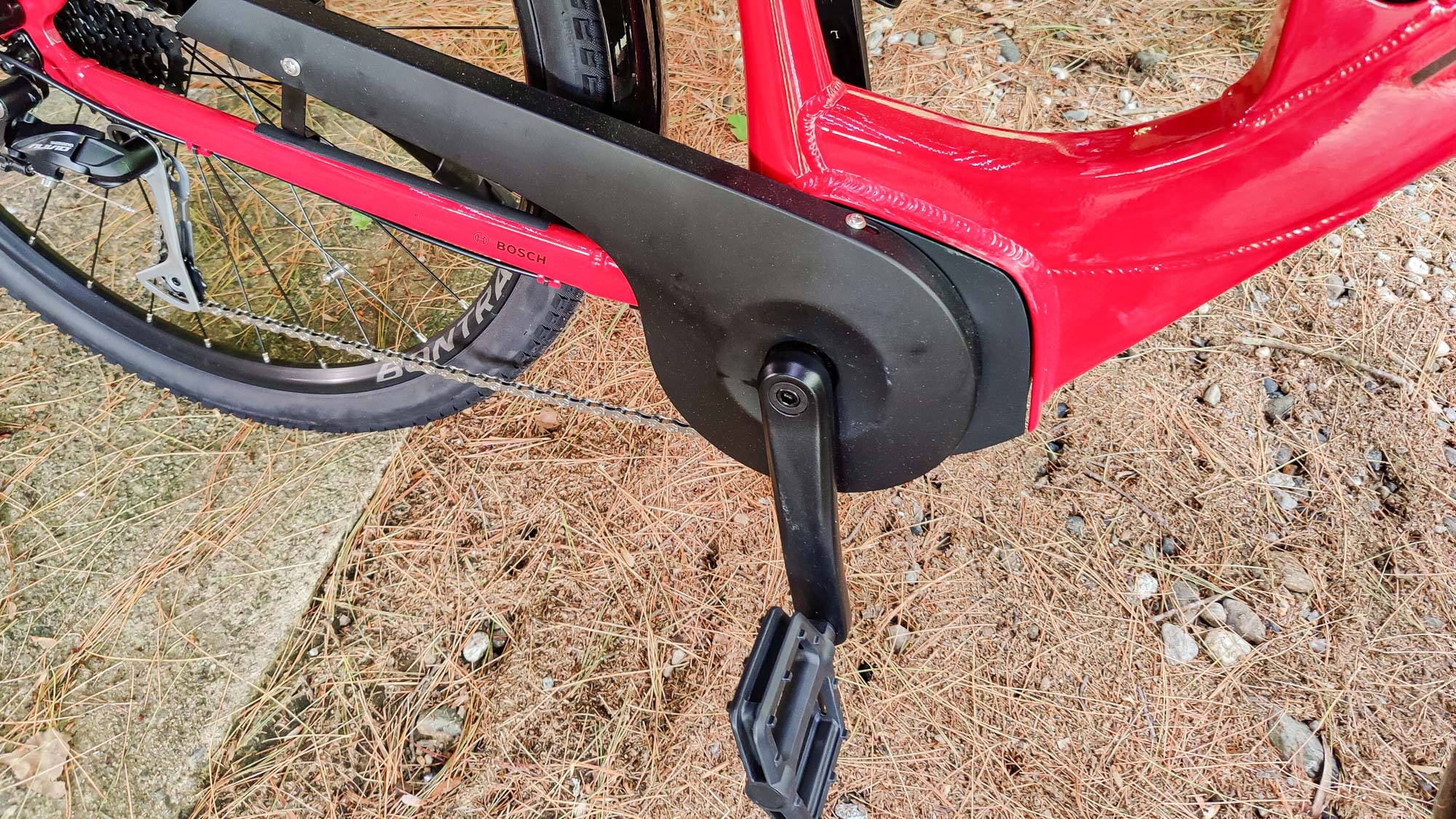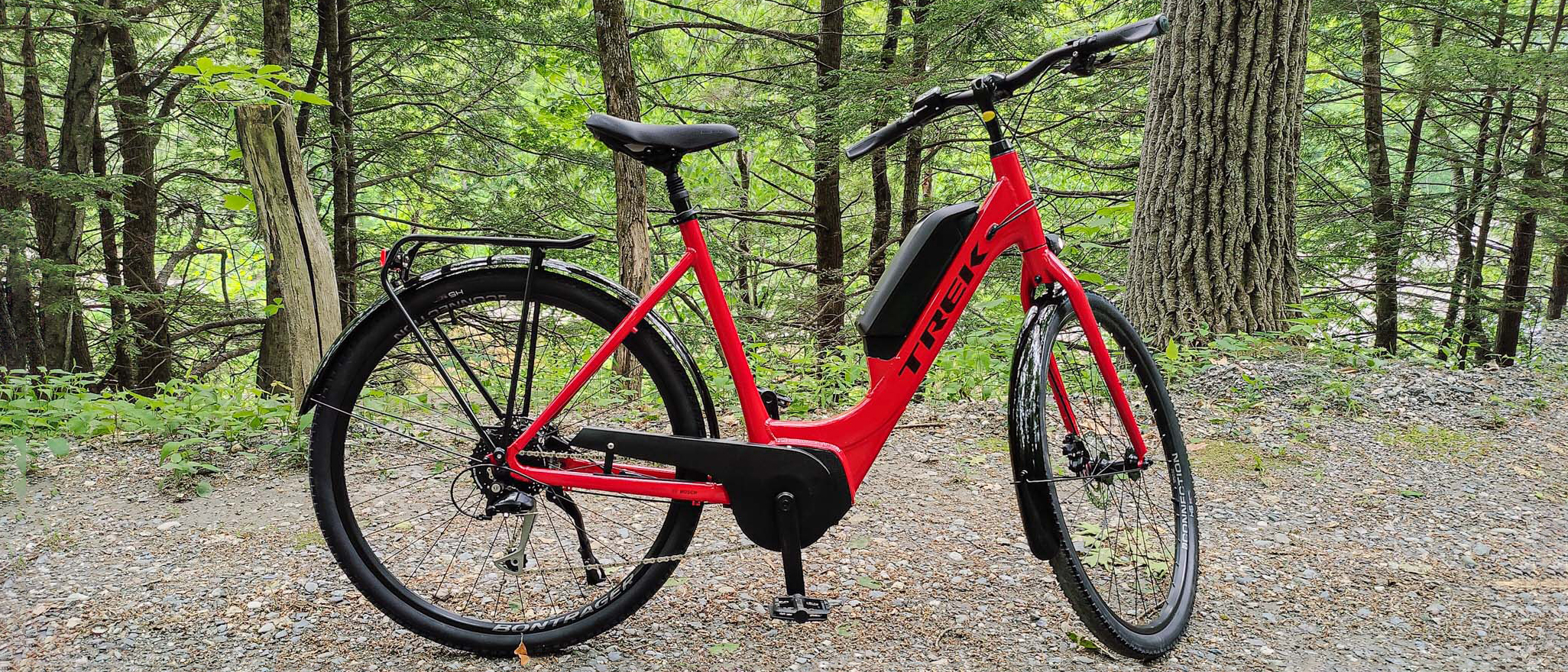Tom's Guide Verdict
The Trek Verve+ 2 is a light and well-balanced electric bike with a responsive Bosch mid-drive motor. However, its relatively limited power assistance and high price makes it a tough sell among equally capable but lower cost ebikes.
Pros
- +
Good balance and handling
- +
Solid components
- +
Responsive motor
Cons
- -
Not much power assistance
- -
No full-throttle mode
- -
High Price
Why you can trust Tom's Guide
Battery: 400 Wh
Max estimated range: 60 miles (Eco mode)
Max assisted speed: 20 mph
Motor: Bosch Active Line 250-watt mid drive motor
Gearing: Shimano Alivio 9-speed
Wheel diameter: 27.5 inches max
Weight: 52 pounds
Most riders will find the Trek Verve+ 2 a little underpowered, especially compared to some of the best budget electric bikes from the likes of Rad Power, Juiced Bikes, and Aventon. On the other hand, for those who think those ebikes are somehow outre and want something subtler, this mild-mannered ebike may be just the thing.
Designed to be a daily commuter and weekend daytripper, the Trek Verve+ 2 doesn't make any radical design statements or excessive power moves. This road bike is for those who want a no-hassle, low-maintenance easy rider with reliable components. Indeed, the low-step version of the Verve+ 2 we tested even makes it easy to climb aboard.
Trek Verve+ 2 Ebike review: Price and availability
Founded in the '70s in Wisconsin, Trek has a reputation for solid construction and reliability — a reputation for which the company hopes shoppers are willing to pay a premium. Sold through retailers, Trek offers an extensive line of bikes, ranging from $13,000 carbon fiber road racers to full-suspension mountain bikes, as well as a full line of ebikes.
The $2,849.99 Verve+ 2 sits somewhere in the middle of the company's ebike line. Compare, for example, Trek's Domane+ ALR, which is a more serious distance road bike that starts at $5,049.99 and the Townie Go 8D EQ Step-Over bike for Sunday beach bathers that starts at $2,449.99.
Trek's bikes are not available directly online but are rather ordered through retailers. The benefit is that you won't have to skin your knuckles assembling it yourself.
Trek Verve+ 2 Ebike review: Design
The Trek Verve+ 2 is designed for casual riders and commuters. It's available in sizes from XS to L, the largest of which will accommodate riders just over 6 feet tall. The bike has an aluminum frame with steel forks and wide straight handlebars for commuter comfort. You won't find mountain-bike style front shocks on the Verve+ 2, but a foam Bontrager seat with a suspension seat post takes the edge off of potholes.

Trek also includes a neat chain guard that runs nearly the full length and ensures you're not going to get a nice pair of pants or skirt mussied up in the gears. Furthermore, the essential power and brake wiring is fed through the down tube to keep things tidy and reduce the chances of damage. For convenience, front and rear quick release wheels are included.

To provide power assist, the Verve+ 2 uses a Bosch Active Line 250-watt, mid-drive motor to deliver smooth support and eliminate surprise surges of power. The bike has a top pedal assist speed of 20 mph and includes a Bosch controller and a 9-speed Shimano drivetrain with a 400Wh removable battery. Rounding out the feature list are hydraulic disc brakes, puncture-resistant tires, a kickstand and front and rear lights, plus metal fenders.

The Verve+ 2 also comes with a rear rack that uses the Racktime clip-on system, which makes it easy to use with compatible panniers and bags. One missing item: a bell or horn is not included, though it does have a headlight and taillight.
Trek Verve+ 2 Ebike review: Performance
The Trek Verve+ 2 offers smooth electric pedal assist performance and predictable handling. Its relatively light weight (52 pounds vs. 70 pounds for some ebikes) also makes it more maneuverable so riders will feel like they're in control of the bike — rather than vice versa.

Although there's no full-throttle mode, on city streets the mid-drive motor, which uses a torque sensor, is very responsive. The instant you apply pressure to the pedals you'll receive some electric assistance. That makes it more seamless than many rear-hub motor models, which tend to suffer from a delay or turbo lag. Consequently, the Trek Verve+ 2 helps you start off from a dead stop, and it's whisper quiet compared to rear motor designs. To bring everything to a halt, the bike's hydraulic brakes are responsive without being too touchy.

Taking the Trek for trips in the countryside presented more of a challenge. The mild power assist even in the top Turbo mode may feel insufficient in helping me climb hills. And if you get caught in the wrong gear on an incline, you'll find yourself getting up out of the saddle. So if you're looking for help on the hills in San Francisco or Asheville, look elsewhere.
One advantage of the Verve+ 2 is that you can use it in full manual mode. Electric support is not necessary. Compare that to big gravel bikes like those from Aventon or Biktrix, which are so heavy you'll never want to be stuck somewhere without power.

The Bosch controller for the electrics displays speed, range, amount of electric assistance selected, and the battery level. There's also a button for walk mode, but you're unlikely to need it unless you're pushing the bike up a steep hill.

We also found that the front headlamp could be brighter for daytime visibility (initially, we didn't realize it was on).
Trek Verve+ 2 Ebike review: Battery life and range
The Bosch controller on the Verve + 2 is a basic LCD display that allows you to choose between four power assist modes: Turbo, Sport, Tour, and Eco. As the nomenclature might suggest, you'll get the most range out of Eco mode--up to 60 miles, according to Trek--and then in descending order less distance the more electric push you ask for with Turbo mode rated for 25 miles.

Because we didn't find the lower power modes much of a help on hills, we primarily used Turbo mode during our weeks of testing. Facing significant hills and with a 170-pound rider aboard, we got an average of 23 miles out of Turbo mode. That's a reasonable result, given the challenging terrain. But depending on where you ride, how much you weigh, and how much electric assistance you prefer, your mileage may vary.
Trek Verve+ 2 Ebike review: Competition
If you're looking for an ebike for between $1,400 and $1,900, there are a raft of choices from reputable but relative newcomers, including the Rad Power Rad City5 Plus, and the Charge Bikes City, both of which cost $1,799. In this end of the market, you'll get more power for your money, but the bikes typically use a less-desirable rear hub motor and are heavier, intended for gravel and occasional off-road use.

If you're considering the more suburban Trek Verve+2 and have the $2,800 to spare, there are plenty of choices from other established brands. Cannondale, for example, offers the Adventure Neo 4 for the same price and boasting nearly the identical powertrain and feature set. However, Cannondale's model has more style than the Trek bike, concealing the battery as part of its downtube, for example.
And if you want a truly no-fuss, sophisticated ebike commuter, our first choice is still the Gazelle Ultimate C380 HMB, although it's considerably more expensive ($4,249).
Trek Verve+ 2 Ebike review: Bottom line
It's difficult to make a value case for the Trek Verve+ 2. Among the best electric bikes and best budget electric bikes, there are many available with comparable abilities and much more power — for a lot less money. On the other hand, lighter casual riders will find the Verve+ 2 more manageable and maneuverable than many of those less expensive models. Furthermore, Trek is sold through traditional brick-and-mortar retailers versus models that are only sold directly online, so buyers don't have to face the annoyance of putting the bike together themselves.
John R. Quain has been reviewing and testing video and audio equipment for more than 20 years. For Tom's Guide, he has reviewed televisions, HDTV antennas, electric bikes, electric cars, as well as other outdoor equipment. He is currently a contributor to The New York Times and the CBS News television program.


